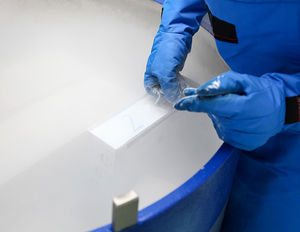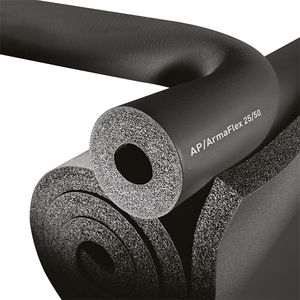By Tim Ledden - Armacell Technical Manager-Insulation
 Armaflex insulation has proven performance insulating cryogenic systems down to -297°F. AP Armaflex is ideal for applications operating all the way down to -40°F because it remains flexible down to -40°F and its excellent thermal conductivity and low water vapor permeability make it extremely efficient at preventing condensation. AP Armaflex may be installed below -40°F but it will be brittle when it reaches temperatures below -40°F. This will not affect thermal conductivity, water vapor permeability, or condensation control but could result in cracking if there is excessive vibration in the system or other movement or impact.
Armaflex insulation has proven performance insulating cryogenic systems down to -297°F. AP Armaflex is ideal for applications operating all the way down to -40°F because it remains flexible down to -40°F and its excellent thermal conductivity and low water vapor permeability make it extremely efficient at preventing condensation. AP Armaflex may be installed below -40°F but it will be brittle when it reaches temperatures below -40°F. This will not affect thermal conductivity, water vapor permeability, or condensation control but could result in cracking if there is excessive vibration in the system or other movement or impact.
If flexibility below -40°F is important, Armaflex LTD remains flexible to -95°F, making it ideal for these applications. Armaflex LTD also has excellent thermal conductivity and extremely low water vapor permeability so it prevents condensation very effectively.
Although either product can be installed on its own, frequently, the best solution for cryogenic applications is to install Armaflex LTD as a first layer, where temperatures will be coldest, and AP Armaflex as subsequent layers. This way one can take advantage of the superior low temperature properties of Armaflex LTD, where they’re needed, and the comparative low cost and wide availability of AP Armaflex for the rest of the system.
Best practices for installing Armaflex insulation can be found in the Armacell Installation Manual and are applicable for cryogenic systems, but the following are some very important installation points that are critical to the performance of Armaflex on cryogenic systems:
1. Use adequate insulation thickness to prevent condensation
The thickness of the insulation is critical to preventing condensation on cryogenic systems. Therefore, one must accurately calculate the required thickness for the worst case ambient conditions. ArmWin® is the most accurate calculator to use with Armacell insulation because it uses actual properties of Armacell insulation instead of ASTM material standard properties like other calculators use. Be aware that the thickness required to prevent condensation in cryogenic applications can sometimes be in excess of 6 inches. Please contact Armacell technical services for advice on thickness or questions about how to use the ArmWin calculator.

2. Install Armaflex under tight compression
Installing Armaflex under compression means to cut the length of each piece of Armaflex 1/4" - 1/2" longer than needed and compress it to fit. This eliminates the stress on joints caused by contraction of the insulation once the system reaches cryogenic temperatures.
3. Install Armaflex in layers with staggered seams
Installing in layers with staggered seams prevents a continuous seam all the way through the insulation to the pipe. This will reduce the likelihood of water vapor entering through a seam and making it to the pipe surface where it can condense.
4. Use vapor retarder with 0 permeance for extreme ambient conditions
For cryogenic application in conditioned space, where temperature and relative humidity are low, no additional vapor retarder is required on Armaflex. For cryogenic applications in areas where the temperature and relative humidity may be high (>80°F and >70% RH) an additional vapor retarder may be necessary. Armachek R is a very effective vapor retarder made from rubber so it expands and contracts with the Armacell insulation. Other vapor retarders may also be used but they should be 100% bonded to Armaflex and have 0 permeance.
5. Do not use Armaflex on systems operating below -297°F without consulting Armacell
Armaflex should not be installed on systems operating continuously below -297°F because of the potential for the formation of liquid oxygen which, under rare circumstances, can be an explosion hazard. For systems operating below -297°F sporadically, Armaflex may be appropriate, but please call Armacell for recommendations for such applications.
